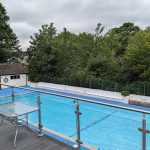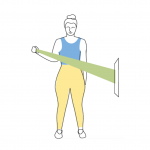Making winter swimming easier
Inland water temperatures in the UK have, in many places, now fallen into single digits, where they’ll probably stay until March or April next year. Anyone who’s swum at these temperatures knows there is a massive difference between 20 degrees, that we sometimes reach in the summer, and less than 10 degrees. Yet, every year, we see increasing numbers of people who want to keep swimming outside.
This raises the questions of where and how to swim safely, and how to make winter swimming easier to do. A number of swimming venues now stay open throughout the year or have allowed dedicated self-managed clubs access to the water at certain times. I’ve recently visited two such places: Bray Lake in Berkshire and Queenford Lake in Oxfordshire. It was interesting to see how the two manage winter swimming.
Bray Lake has introduced a “Winter Swim Buddies” programme. The venue has been open for winter swimming for the past four years, with a core group of 15-20 regulars turning up each week and on occasions even breaking the ice to get into the water but this year, demand has gone up.
Simon Frost, owner of Bray Lake Watersports, says: “Whether it’s because this group have been proclaiming to all and sundry just how much fun winter swimming can be, or whether it’s a result of this summer’s sunny weather and warm water bringing more swimmers to the lake more often, but over the last few weeks of summer more people than usual were asking about winter swimming. Despite this interest though, many were apprehensive, saying that they had tried it before but had struggled with the cold. Others liked the idea, but weren’t sure how to go about it, or if their bodies would cope.”
Two winter swimming regulars at the lake, Nigel Stock and Jane Drapkin, therefore decided to hold coffee and cake mornings with potential winter swimmers and share their tips and experience with swimmers contemplating continuing in open water all year. Through this, they were able to advise on how to get into cold water safely, to bring warm clothes that don’t have zips, buttons or clasps, and how to deal with after-drop.
Both Nigel and Jane freely admitted that their minds and bodies have had to overcome significant challenges to enable them to transition from warm water and neoprene clad swimmers to cold water skins swimming addicts.
To provide further support, many of the regular seasoned winter swimmers then volunteered to act as “buddies” to the newbies to help ensure they stayed safe and had a fun environment in which to enjoy cold-water swimming over the winter.
So successful were these sessions that Bray Lake still has more than 80 swimmers swimming in October, an unheard of number before this year.
New winter swimmer Sue Anstiss says: “This is the first year that I have decided I’d love to swim at Bray Lake throughout the whole winter. I’ve not swum in the lake without a wetsuit before and usually stop around August. My goal is to stay in skins and treat it more as a special cold water experience each weekend rather than thinking of it as fitness training. The session where Jane and Nigel shared their tips was absolutely brilliant and it has given me massive confidence that we can all do this. They made me realise that everyone feels the same way, but with the correct preparations and precautions anything is possible! I feel much more confident that I can do this and there will always be great support from the rest of the group at the Lake.”
Meanwhile, around 50 miles away at Queenford Lake, winter swimming is also going strong, with similar numbers turning up each week. Rather than being organised by the lake owner, the venue manager has enabled regular swimmers to set up a winter swimming club, which has already reached full capacity this year. The club is responsible for organising swim sessions and providing its own safety cover. A small loop is marked out so that swimmers are never too far from the exit and can be watched by a lifeguard on the pontoon and a second in a kayak on the water. The swimming session is only an hour long to ensure everyone comes at a similar time and most swim for much less than the full hour, depending on the water temperature. Both wetsuit and skins swimmers are welcome and there is a supportive and encouraging environment for everyone.
Winter swimming outside, despite being eccentric (to put it kindly), seems to be hugely beneficial. Its fans boast of improved resistance to colds and other infections and just feeling great. There’s no doubt that swimmers enjoy the buzz and camaraderie they get from plunging into cold water with a group and then sharing shivers and coffee after. Bray Lake swimmer Jack Bearfox agrees:
‘’I found open water swimming when I was going through a bit of a rough time in life and needed some mental clarity. Outdoor swimming is like therapy. Not only do you feel the adrenalin of being in open water – you are also surrounded by nature and friendly swimmers. It’s exhilarating and soul soothing at the same time.’’
We’d be interested to hear from other venues that have stayed open through the winter and how they are supporting cold water swimming.
#SwimWildAndFree
Find out more







